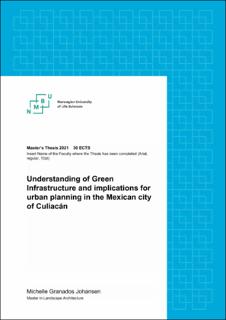| dc.description.abstract | Green Infrastructure (GI) means an interconnected network of natural, semi-natural and artificial elements for the associated ecosystem services it provides to the population. The city of Culiacán currently does not have a plan for Green Infrastructure, or even green spaces in general. Without a unified vision, independent interventions behave like islands. Therefore, it was an objective for this master thesis to provide a knowledge-based framework for future landscape architecture interventions in the city. This study aims to integrate the qualities of existing Urban Green Spaces (UGS) and the vision for improvement into a unified Green Infrastructure plan. For this, it was necessary to find out where the potential for the city to incorporate GI strategies is. Cartographic and documental information was used to provide a panorama of the situation, to diagnose where the main issues are. Multiple methods to process the information included remote sensing, spatial analyses, and an in-depth interview. The results suggest that existing Urban Green Spaces are scattered and isolated, that only 5% of the city’s total surface area is destined to recreational green spaces, and that 48% of the population do not have access to high quality UGS by walking distance (300 m). Similar to other Latin American cities, an unequal distribution of UGS favoring those of highest income was observed throughout the study. Moreover, the results on the spatial analysis confirmed a relation between the lack of vegetation and the extreme warm temperatures. The use of exotic species, vulnerability to flooding, and the degradation of the river were the most recurrent environmental problems. At the end, a strategic Green Infrastructure proposal was made to reduce issues related to environmental inequality and to increase urban resilience. It is ultimately the vision for this proposal to become a planning tool to bring Culiacán closer to reaching the Sustainable Development Goal 11 by contributing to a more inclusive, safe, resilient, and sustainable city. | en_US |

